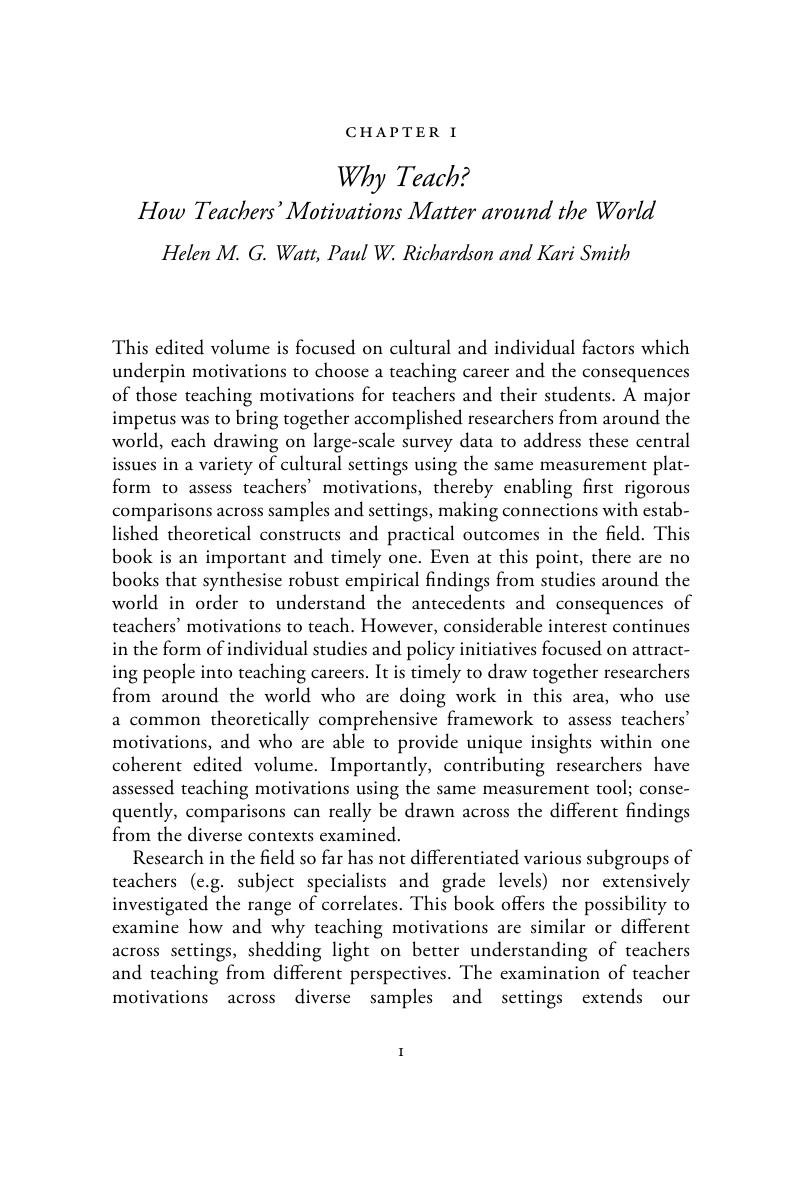Book contents
- Global Perspectives on Teacher Motivation
- Current Perspectives in Social and Behavioral Sciences
- Global Perspectives on Teacher Motivation
- Copyright page
- Dedication
- Contents
- Figures
- Tables
- Boxes
- Contributors
- Chapter 1 Why Teach?
- Chapter 2 Career Motivations of Student Teachers in the Republic of Ireland
- Chapter 3 Why Teach?
- Chapter 4 Factors Motivating Students to Become Secondary School Teachers
- Chapter 5 The Motivational Basis of Classroom Management Practices and Beliefs of Swiss Vocational Teachers
- Chapter 6 Motivations That Affect Professional Knowledge in Germany and Austria
- Chapter 7 Teaching Motivations and Perceptions during the First Year of Teacher Education in Estonia
- Chapter 8 How Personality Dimensions and Motivation to Teach Shape the Learning Achievement Goals of Croatian Future Teachers
- Chapter 9 Exploring the Relationships between Prospective Turkish Teachers’ Hopes, Motivations and Professional Plans
- Chapter 10 Motivations and Aspirations of Teacher Education Students in Indonesia
- Chapter 11 Teacher Motivation and Professional Commitment in the United States
- Chapter 12 Divided by Discipline?
- Chapter 13 Why Choose Teaching, and Does It Matter?
- Index
- References
Chapter 1 - Why Teach?
How Teachers’ Motivations Matter around the World
Published online by Cambridge University Press: 20 September 2017
- Global Perspectives on Teacher Motivation
- Current Perspectives in Social and Behavioral Sciences
- Global Perspectives on Teacher Motivation
- Copyright page
- Dedication
- Contents
- Figures
- Tables
- Boxes
- Contributors
- Chapter 1 Why Teach?
- Chapter 2 Career Motivations of Student Teachers in the Republic of Ireland
- Chapter 3 Why Teach?
- Chapter 4 Factors Motivating Students to Become Secondary School Teachers
- Chapter 5 The Motivational Basis of Classroom Management Practices and Beliefs of Swiss Vocational Teachers
- Chapter 6 Motivations That Affect Professional Knowledge in Germany and Austria
- Chapter 7 Teaching Motivations and Perceptions during the First Year of Teacher Education in Estonia
- Chapter 8 How Personality Dimensions and Motivation to Teach Shape the Learning Achievement Goals of Croatian Future Teachers
- Chapter 9 Exploring the Relationships between Prospective Turkish Teachers’ Hopes, Motivations and Professional Plans
- Chapter 10 Motivations and Aspirations of Teacher Education Students in Indonesia
- Chapter 11 Teacher Motivation and Professional Commitment in the United States
- Chapter 12 Divided by Discipline?
- Chapter 13 Why Choose Teaching, and Does It Matter?
- Index
- References
Summary

- Type
- Chapter
- Information
- Global Perspectives on Teacher Motivation , pp. xv - xviPublisher: Cambridge University PressPrint publication year: 2017
References
- 8
- Cited by



